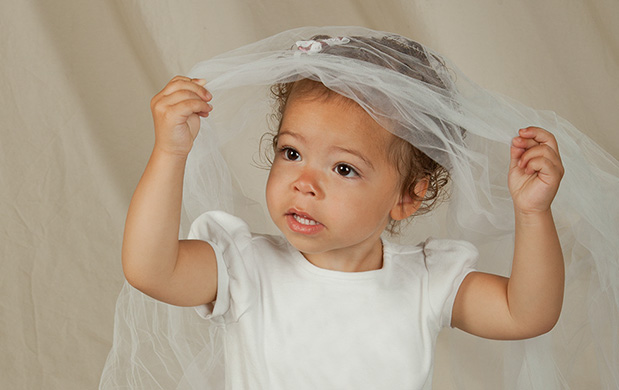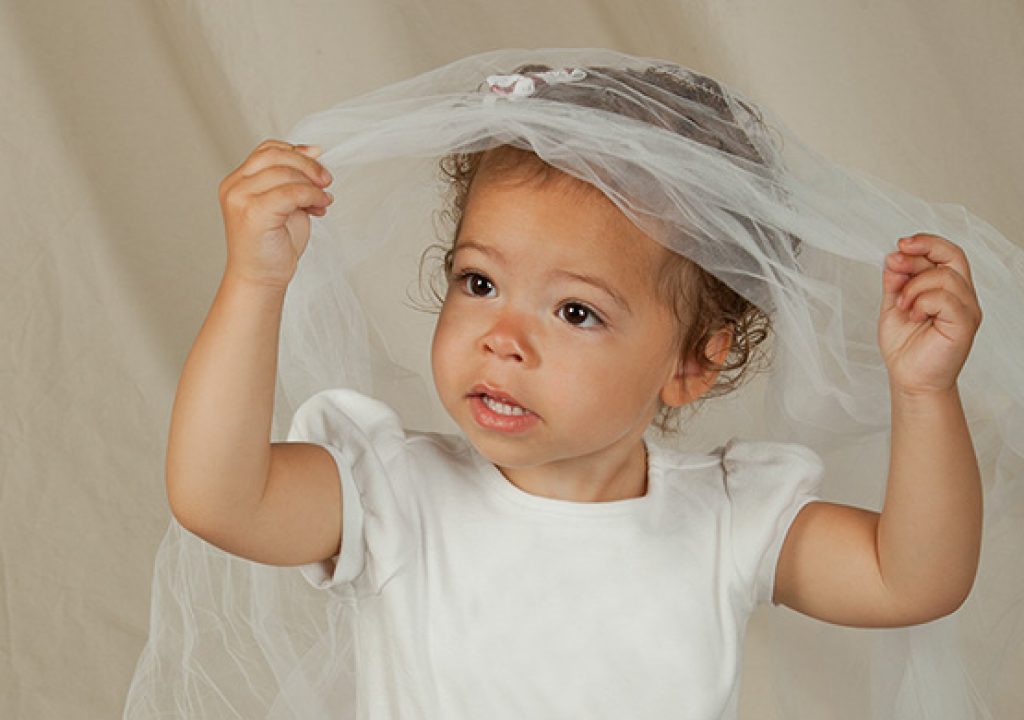
Making a great experience for child and infant portraits and their parents is a the only way to get and retain clients. Whatever you scenario – brick and mortar studio, home studio or in-the-home outcall sittings – there is a lot of pre-planning needed to set your services aside as worthy of significant investment rather than parents just making their own snaps.
The specialized field of newborn and young children’s pictures has always been the natural province of women photographers. We love Dads to be involved in sittings, but most clients say that women photographers are just a bit more sensitive to the subtleties of little people. Currently, more and more young women, often with babies of their own, are finding pictures of little people are a great way to break into the industry. Gentler, patient instinct takes over. And the amount of hand-holding necessary to attract client dollars.
For some good background material from younger generation photographers, I recommend the August issue of Professional Photographer baby photo ideas. There’s a series of articles with differing views that are worth reading. I’m going to weigh in with some key points of experience over a number of years of stylistic changes and approaches.
Because kid photography is currently a more casual, home snap shot scenario, new parents can be very concerned about studio comfort, safety and experience.
First time moms and dads often don’t even know the right questions to ask. Your job as photographer is to patiently explain what will happen and how best for clients to prepare. They generally won’t know simple, intuitive things like making sure baby has a snack before the sitting, or that clothing pulled over a tiny head in unfamiliar surroundings can easily cause tears. Warmth and cleanliness must be assured. Explain the measures you take to prevent baby from rolling off a posing bench. I find that infants with or without parents are more easily and satisfactorily photographed in a controlled environment, whether you do this in a brick and mortar studio, your home studio or set up a mini studio in that of your client. Many questions to prospective clients about their ideas and preferences will suggest to you an individual approach – nothing cookie cutter even for newborns. I always let the planned sitting style dictate place and approach for one year and up, because this is when little personalities will appear.
Good clothing choices and attractive triangular composition.
I always remember that people are nervous about allowing a stranger to handle their precious bundle. Time spent in pre-sitting consultation will begin to make you their friend; you must prove yourself worthy of trust. Women photographers easily do this by relating experiences or anecdotes getting their own kids in front of the camera.
Privacy of the photo sitting experience is something everyone values.
Interruptions of phone, doorbells, assistants coming in and out are just plain unwelcome and disruptive to the mood. Image quality can suffer. However, “shush” quiet for sleeping and nursing babies changes to fun and sometimes noisily upbeat chatter for older children. Kid songs, cartoon music, silly jokes, making faces, dancing are all important parts to keep young energy going. You have to be willing to be silly and engage little personalities to interact. I still don’t know why that old ploy of blowing bubbles works so well – but it does. Maybe bubbles are an ice breaker. So are gentle tickle feathers on long sticks. Favorite tip: I keep yards of feather-light, white tule fabric to wind up in nests for babies. Older children dance with it, hide under it and generally have tremendous fun with this cheap, reusable netting.
Flash can be as disruptive as strange noises. Constant source lighting makes for calmer, more intimate portrait sessions.
There are obvious advantages of flash for the fast, casual life-style work that is currently fashionable. We all want flash power for crispness and higher ‘-stops, particularly for closeups. Kids are small, so even if you use a short telephoto lens, you are working at very close range. Yes you want a bokeh focal vignette effect, but you actually need lots of depth of field, because babies tend to flop their heads around and you don’t want out of focus disappointment. The other problem is the need for a fast shutter speed, because expressions are usually fleeting. Motion blur is not an option. But that flash pop noise can scare children, wake a sleeping infant or simply destroy an intimate mood. “Hot” lights are a viable, less expensive way to go, but over a longer, varied session they are a pain. They don’t always have rheostats for variable power output, so you have to physically move them and be careful not to touch hot parts. Try commercial studio LED panels or multi-tube fluorescents; they’re the modern solution.
Style and clothing consultation pre-sitting is the lion’s share of first class studio experience. It can make the difference between a smooth running session and a disjointed one, as well as a superior final product.
Intuitive selection of outfits, colors, textures and backgrounds is not something in client vernacular – if it ever was! Adults, unguided, will make serious mistakes about clothing. Outfits should be plain and simple- though a ruffly peignoir or blouse can be lovely and romantic. This is very traditional, but plain clothing will always emphasize the faces. While not a totally wrong choice, today’s fashionable plaids and florals inevitably distract the eye from expressions. Later on these outfits will be historic, but dated, kind of like old Norman Rockwell drawings of kids and families from the 40‘s and 50’s.
Color or Black & White? Difference in feelings.
Plain clothing goes for baby too. Almost always clients come with logo outfits for kids. I’ll make a couple of snaps of a gift outfit (grandma sent a blue onesie with red trains all over it) and give these files to the client gratis to satisfy the giver. Once that’s done, I can easily convince the client to move on to more classic style. The best classic is, of course, no clothing at all. I love this for parents as well, but these days I find clients are less open to nudes than in the past. Edgy does not seem to be as fashionable. From the photographer’s stand point the nude group will be harder to do tastefully. Favorite tip: for a nude maternity image, perhaps including Dad, there is no need to show faces.
Nude studies do not need to show identifiable faces of parents.
Pre-sitting consultation must include the essential matter of display of the final portrait. It’s your final pre-production job where you must lead your client toward greatest enjoyment of their investment.
If your client is excited about the nude direction, find out if they plan to hang the portrait in their bedroom where it can be as edgy as you like, or in a more public part of the house which will dictate a more discrete composition. I never suggest hanging a nude, either baby or family, by in a group on a family history, travel or wedding wall. These are best displayed as singles or a group of nudes. Hand printed black and white gicl©e is a great way to go, and has the added benefit of eliminating colors when clients don’t come with optimal clothing in spite of consultation. Black and white is an evergreen. It’s always smart and fashionable, a real conversation starter, which means people who see and like your work in your client’s home will ask for your website and phone. Great advertising.
But in today’s market, a beautifully matted and framed black and white can run into more investment than may be comfortable for some clients. For best business approach, you want them to come back more often, rather than blow the entire budget one time, and then not return for 10 years – or maybe never. I love the way contemporary canvases (that need no framing) look fresh, new and arty, may be your best answer for tight budgets as well. Many labs make them – but you know my favorite The Gicl©e Factory superior photo canvases for quality, color tone and price. They simply never fail – but that’s because they know all kinds of fine art and how best to reproduce it.

